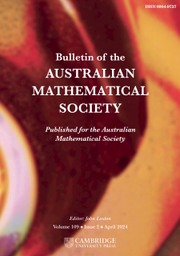No CrossRef data available.
Article contents
A NOTE ON  $\def \xmlpi #1{}\def \mathsfbi #1{\boldsymbol {\mathsf {#1}}}\let \le =\leqslant \let \leq =\leqslant \let \ge =\geqslant \let \geq =\geqslant \def \Pr {\mathit {Pr}}\def \Fr {\mathit {Fr}}\def \Rey {\mathit {Re}}K$-SPACES
$\def \xmlpi #1{}\def \mathsfbi #1{\boldsymbol {\mathsf {#1}}}\let \le =\leqslant \let \leq =\leqslant \let \ge =\geqslant \let \geq =\geqslant \def \Pr {\mathit {Pr}}\def \Fr {\mathit {Fr}}\def \Rey {\mathit {Re}}K$-SPACES
Published online by Cambridge University Press: 12 May 2014
Abstract
Core share and HTML view are not available for this content. However, as you have access to this content, a full PDF is available via the ‘Save PDF’ action button.
In this paper, it is shown that every compact Hausdorff  $K$-space has countable tightness. This result gives a positive answer to a problem posed by Malykhin and Tironi [‘Weakly Fréchet–Urysohn and Pytkeev spaces’, Topology Appl.104 (2000), 181–190]. We show that a semitopological group
$K$-space has countable tightness. This result gives a positive answer to a problem posed by Malykhin and Tironi [‘Weakly Fréchet–Urysohn and Pytkeev spaces’, Topology Appl.104 (2000), 181–190]. We show that a semitopological group  $G$ that is a
$G$ that is a  $K$-space is first countable if and only if
$K$-space is first countable if and only if  $G$ is of point-countable type. It is proved that if a topological group
$G$ is of point-countable type. It is proved that if a topological group  $G$ is a
$G$ is a  $K$-space and has a locally paracompact remainder in some Hausdorff compactification, then
$K$-space and has a locally paracompact remainder in some Hausdorff compactification, then  $G$ is metrisable.
$G$ is metrisable.
MSC classification
Information
- Type
- Research Article
- Information
- Copyright
- Copyright © 2014 Australian Mathematical Publishing Association Inc.
References
Arhangel’skii, A. V., ‘Quotients with respect to locally compact subgroups’, Houston J. Math. 31 (2005), 215–226.Google Scholar
Arhangel’skii, A. V., ‘Two types of remainders of topological groups’, Comment. Math. Univ. Carolin. 49 (2008), 119–126.Google Scholar
Arhangel’skii, A. V. and Tkachenko, M., Topological Groups and Related Structures (Atlantis Press, Amsterdam–Paris, 2008).Google Scholar
Engelking, R., General Topology, Revised and completed edition (Heldermann Verlag, Berlin, 1989).Google Scholar
Gruenhage, G., ‘Generalized metric spaces’, in: Handbook of Set-Theoretic Topology (eds. Kunen, K. and Vaughan, J. E.) (Elsevier, Amsterdam, 1984), 423–501.CrossRefGoogle Scholar
Henriksen, M. and Isbell, J. R., ‘Some properties of compactifications’, Duke Math. J. 25 (1958), 83–106.CrossRefGoogle Scholar
Hodel, R., ‘Cardinal functions I’, in: Handbook of Set-Theoretic Topology (eds. Kunen, K. and Vaughan, J. E.) (Elsevier, Amsterdam, 1984), 3–61.Google Scholar
Malykhin, V. I. and Tironi, G., ‘Weakly Fréchet–Urysohn and Pytkeev spaces’, Topology Appl. 104 (2000), 181–190.CrossRefGoogle Scholar
Pasynkov, B. A., ‘Almost-metrizable topological groups’, Dokl. Akad. Nauk SSSR 161 (1965), 281–284.Google Scholar
Shapirovskii, B., ‘On π-character and π-weight of compact Hausdorff spaces’, Soviet Math. Dokl. 16 (1975), 999–1003.Google Scholar
Wang, H. F. and He, W., ‘Notes on K-topological groups and homeomorphisms of topological groups’, Bull. Aust. Math. Soc. 87 (2013), 493–450.Google Scholar

